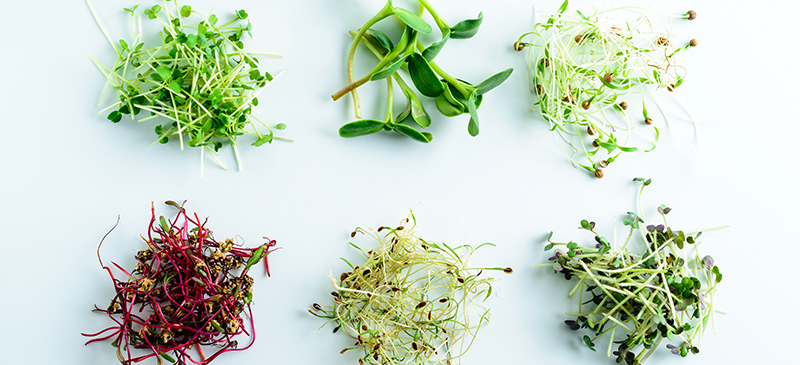What is Microgreen?
Microgreens are usually 2.5−7.6 cm (1−3 in.) in height, tiny green leaves, bigger then sprout harvested at 7−14 days after germination, depending on the species.
Why Microgreen is so popular?
All these microgreens have much higher levels of vitamins, minerals, and other health-giving phytonutrients than the mature leaves.
Also, microgreens can provide surprisingly intense flavours, vivid colours, along with crisp textures and can be served as an edible garnish or a new salad ingredient.
Nutrition Summary in Microgreen
According to USDA National Nutrient Database, the microgreen cotyledon leaves possessed higher nutritional densities as well higher nutritional concentrations than mature leaves.
Many Studies have shown that young seedlings may have much higher levels of vitamins, minerals, and other health-giving phytonutrients than the mature leaves. In a recent study from Lester it was reported that the younger leaves of baby spinach (Spinacia oleracea L.) generally had higher levels of phytonutrients.
Department of Nutrition and Food science, University of Maryland, College Park, has published one Research report about nutrition’s in microgreens. They studied concentrations of ascorbic acid, carotenoids, phylloquinone, and tocopherols in 25 commercially available microgreens.
In their research they have focused on human bioactive compounds. Their examination includes
1) ascorbic acid
2) carotenoids (β-carotene, violaxan-thin, and lutein/zeaxanthin),
3) phylloquinone,
4) tocopherols (α- and γ-tocopherol)
Results showed that different microgreens provided extremely varying amounts of vitamins and carotenoids.
Among the 25 microgreens analysed, red cabbage, cilantro, garnet amaranth, and green daikon radish had the highest concentrations of ascorbic acids, carotenoids, phylloquinone, and tocopherols, respectively. Research summary on Vitamin in microgreens
All these microgreens have much higher levels of vitamins, minerals, and other health-giving phytonutrients than the mature leaves. However
· Red cabbage is rich in Vitamin C
· Garnet amaranth is rich in Vitamin K1
· Green daikon radish is rich in Vitamin E
· Cilantro: In terms of carotenoids, cilantro microgreens showed the highest concentration of lutein/zeaxanthin and violaxanthin and ranked second in β-carotene concentration
· popcorn shoots and golden pea tendrils were relatively low in vitamins and carotenoids, although they were still comparable nutrition-ally to some commonly consumed mature vegetables.
Environmental Conditions for Microgreen
Environmental conditions, i.e., quality of soil, PH value, manure, temperature and humidity, and harvesting methods affect the growth, yield and nutrient content of microgreens.
· Light: It is noted that golden pea tendrils, which are grown in the absence of light, processed much lower vitamin and carotenoid concentrations than pea tendrils grown under light, suggesting that light plays an important role on nutriential values during the growth of microgreens.
· PH Value: Microgreens seeds are sensitive to the pH of water. Most microgreens will do best at a pH of 6. A range of 5.5 to 6.5 is acceptable.
· Temperature & Humidity: Microgreen grows well in warm temperature and well-light area.
· Soil: a soil mix or even just a 50/50 blend of perlite & vermiculite is popular for microgreen, however growing mats works fine for microgreen.
How to choose Microgreen?
When choosing a microgreen, researchers say to look for the most intensely coloured ones, which will be the most nutritious.
How to consume Microgreens?
Microgreens (seedlings of edible vegetables and herbs) are small in size, however microgreens can provide surprisingly intense flavors, vivid colors, and crisp textures and can be served as an edible garnish or a new salad ingredient.
· Salad: They make great addition to traditional tomato, cucumber salad. There are many varieties and you can experiment with mix and match in terms of colour and taste
· Sandwiches: They are delicious addition to veg sandwiches.
· Garnishing: Because of vivid colours, intense flavours along with crisp textures, microgreens are an excellent choice for garnishing your cuisine


Leave a Reply